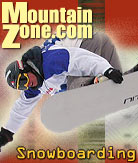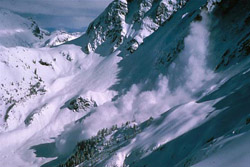
|
The Most Important Tool is Knowledge Avalanche Awareness with Gary Brill January 8, 2006
Pages »1 2
Editor's Note: References to incidents in the article took place in the winter of 2000. You look at the slope just beyond the "Closed Area" boundary sign, checking out the fresh snow beyond— best stuff you've seen all season. Just a couple of days ago, you saw people ski it and it looked fantastic. A steep chute with a foot of fresh—what could be better? You check to see if the patrol is around and then duck quickly under the rope. You just made a big mistake. Did you check to see what the avalanche forecast was? Did you check the snowpack to see if there was instability present since the last snowfall? Above all else, have you taken the time to equip yourself with the knowledge necessary for assessing potential avalanche conditions? "Make sure that you have a good education or background in avalanche knowledge to make sure that you don't go beyond your skill levels," says Gary Brill, Director of Winter Programs for Mountain Madness and former heli-ski guide for the world famous Canadian Mountain Holidays operation. "You should do these things for yourself, not to impress people or whatever it might be, or whatever that drive might be." When you step outside the rope, to ski into a closed section within a ski area, or go for a full-on backcountry travel experience, you need to be absolutely aware of what kind of snow conditions you will be encountering. The backcountry experience is becoming very popular as skiers and snowboarders seek fresh tracks and exciting terrain outside resort area boundaries. "The risk is that a lot of people get into it without having a real foundation of knowledge..." Recent avalanche deaths in Utah, Colorado and Washington have increased attention to the fact that many new backcountry travelers are not exercising good judgment when entering terrain with uncertain snow conditions. "I do think there is an increase in population in general in these areas," says Brill, himself an avid backcountry skier for over 30 years. "To the extent that these people develop their knowledge, over time, with respect for the mountains, I think it's a good thing. The risk is that a lot of people get into it without having a real foundation of knowledge."
In mid-January, two skiers ignored a high wind closure on the upper lifts of Washington's Crystal Mountain. As they hiked up a very steep inbounds area known as Snag Chutes, a patroller shouted up to them and warned them of the avalanche danger. Ignoring the warning, the pair continued on. When they reached the top of the steep chute (with a slope pitch of approximately 38 degrees), the two discussed the possibility of an avalanche. They were concerned enough to decide to ski into the chute one at a time. The first skier set off a slide that carried him through the chute and buried him under three-and-a-half feet of snow. He did not survive. A week earlier, in Utah, two skiers, a husband and wife, left the boundaries of The Canyons ski area and headed for an accessible backcountry area. As they approached the boundary, they were cautioned strongly by a patroller who warned them not to leave the area due to the high avalanche danger in the backcountry. The skiers chose to ignore the warning and hiked approximately one mile to a steep 38 to 48 degree pitch. It is assumed they started skiing down the slope at the same time. The slope avalanched and both were buried. After an extensive search, their bodies were found the next day. Both skiers suffocated. In Colorado in late January, two snowboarders were riding in an area near Arapahoe Basin called the Steep Gullies. Typically accessed from the lifts at A-Basin, the Steep Gullies are a popular backcountry destination. That week saw heavy snowfall and subsequent warnings of high avalanche danger from the Colorado Avalanche Information Center. Page 2 »
|
